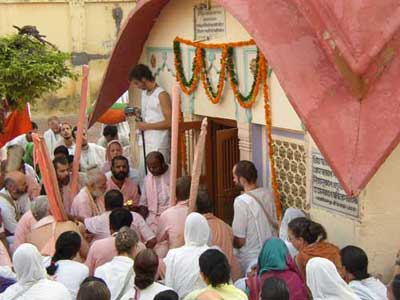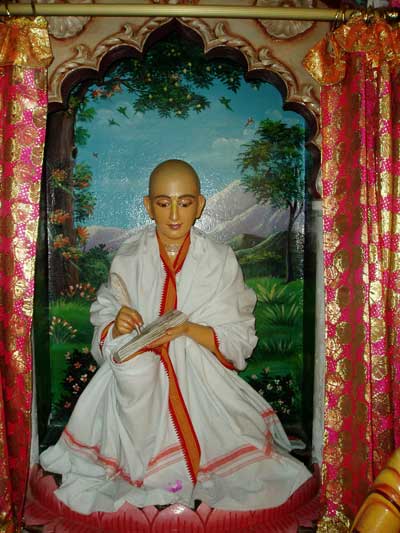Sri Srimad Bhaktivedanta Narayana Gosvami Maharaja
[For the divine disappearance day of Srila Rupa Gosvami and for your own transcendental reading pleasure on this day, and for your sharing with friends, we are happy to present Srila Narayana Gosvami Maharaja’s discourse on Srila Rupa Gosvami’s glories, spoken at Sri Rupa Sanatana Gaudiya Matha on August 6, 1998.. View video here. Sincerely, the Harikatha team]
In Sri Krsna’s pastimes, Srila Rupa Gosvami is Rupa-manjari, a special maidservant of Srimati Radhika. Rupa-manjari is always serving Srimati Radhika, and she is always on Her side. If Krsna orders her to do something, she will not be afraid to disobey, and by disobeying she will be so pleasing to Krsna. Among all the maidservants of Radhika, including Rati-manjari (Raghunatha dasa Gosvami) and Labanga-manjari (Sanatana Gosvami), she is the most prominent. Ananga-manjari, the younger sister of Radhika, is her bosom friend.
Because Rupa-manjari is the prominent maidservant of Srimati Radhika and always lives with Her, she knows some things that are unknown even to the closest sakhis (gopi friends) of Radhika, namely Lalita, Visakha, and Tungavidya. By her causeless mercy, she came in the form of Srila Rupa Gosvami, the associate of Sri Caitanya Mahaprabhu.
All of the associates of Krsna act as if they are dumb when it comes to expressing themselves about their own loving exchanges with Sri Krsna. They personally relish Krsna’s pastimes, but they cannot tell anything about their experiences. Radhika will also not tell anything about how She meets with Krsna. Sometimes, in the early morning, Syamala visits Srimati Radhika and asks, “I want to hear something from You. I want to take bath in hearing Your krsna-katha; I want to hear how You met with Krsna last night.” Srimati Radhika replies, “I don’t remember. I went there and I saw Him, and then I fainted, and I don’t know anything about what happened after that.”

If Candravali asks what happened, Radhika’s sakhis tell the opposite of what actually transpired. They will not reveal what incidents actually took place. Whenever they are asked this question, all act as if dumb. Neither Lalita nor Visakha nor any other sakhis will tell, and even Krsna will not tell what happened. They will relish their pastimes together, but not tell others about them.
Caitanya Mahaprabhu has said:
na prema-gandho ’sti darapi me harau
krandami saubhagya bharam prakasitum
vamsi vilasy anana lokanam vina
bibhrami yat prana patangakan vrtha
(Caitanya-caritamrta, Madhya-lila 2.45)
[“My dear friends, I have not the slightest tinge of prema within My heart. When you see Me crying in separation, I am just falsely exhibiting a demonstration of My great fortune. Indeed, not seeing the beautiful face of Krsna playing His flute, I continue to live My life like an insect, without purpose.”]
Mahaprabhu said, “I have not a scent of that prema.” In this way, He is also as if dumb.
In Srila Raya Ramananda’s conversation with Sri Caitanya Mahaprabhu (Ramananda-samvada), Raya Ramananda – who is Visakha in Krsna’s pastimes – barely told anything. He was simply replying to Mahaprabhu’s questions, one after another. In Mahaprabhu’s instructions to Srila Sanatana Gosvami (Sanatana-siksa), what did He tell? He did not say anything about the confidential pastimes of Sri Sri Radha-Krsna, nor did He reveal how the gopis serve Them.
What has Mahaprabhu told in His instructions to Srila Rupa Gosvami in Sri Rupa-siksa? He told next to nothing regarding Radha and Krsna’s pastimes. And finally, He ordered Rupa Gosvami to reveal all that He Himself could not.
Even Rupa-manjari cannot tell anything. Only Rupa Gosvami can tell; he tells everything.
Srila Rupa Gosvami is very intelligent and expert. He explains how, in the form of Rupa-manjari, he personally serves Srimati Radhika in Krsna’s pastimes. For example, he sees that Srimati Radhika has appointed him, in the form of Rupa-manjari: “O my dear sakhi, please stand at the door of the kunja and do not allow anyone to come to Me, especially that black person (Krsna). He should not come to Me. He might come disguised as a girl; His cowherd friend Subala is so expert that he may disguise Him as a very enchanting gopi. If that happens, you should know that it is Him.”
Srila Rupa Gosvami is seeing: “Srimati Radhika has told me to do this, and I am now standing guard at the door of Her kunja. When Krsna comes in the disguise of any girl, I will chastise Him because of His misbehaviour towards Radhika and not allow Him to enter. Will such a day ever come to me, that I may perform that service?”
He tells us what he has seen: In the form of Rupa-manjari he is serving Krsna and Srimati Radhika. He is obeying the orders of Srimati Radhika and stopping Krsna from entering Her kunja. He is seeing how Krsna, being so much pleased, is begging her to be allowed to enter Radhika’s kunja and is placing His head at her (Rupa-manjari’s) own lotus feet to attain her (Rupa-manjari’s) mercy.
Srila Rupa Gosvami is very clever. He has written all his prayers as though he has not already experienced the fruit of those prayers. Although he has actually experienced his personal services to Radhika, he is writing prayers as if he has never experienced this – for us. What he felt in the form of Rupa-manjari, he has very cleverly shared with us by means of his prayers.
Rupa Gosvami has personally taken darsana of Radha and Krsna, but for the true, sincere sadhaka, he has written this verse in his prayer, “Gandharvika Prarthan-astakam”:
vrndavane viharator iha keli kunje
matta dvipa pravara kautuka vibhramena
sandarsayasva yuvayor vadanaravinda
dvandvam vidhehi mayi devi krpam prasida (1)
[“O devi Radhike! Like the intoxicated king of elephants sporting with his queen elephant, Sri Krsna and You are constantly enjoying Your ambrosial amorous pastimes in the lush pleasure groves of Vrndavana. Therefore, O Gandharvike, be pleased with me and mercifully grant me the darsana of Your two lotus-like faces.”]
Srila Rupa Gosvami is teaching by his own example how a rupanuga Vaisnava prays to Srimati Radhika. Those who want to follow him never pretend to have already attained ekadasa-bhava (gopi-bhava, or manjari-bhava). Those who pretend to be already on that platform when they are actually not so, are actually mad; they have no sense at all. We should always pray as Srila Rupa Gosvami prayed. Then, by the mercy of the gopis and by the mercy of Srimati Radhika, we can realise all the truths hidden within Rupa Gosvami’s prayers. Srimati Radhika will give this realization. She will at once be pleased and give Her service.
Srila Rupa Gosvami teaches us how to pray: “Vrndavane viharator iha – O, when will that time come? O my dear Srimati Radhika-devi, You are very merciful, so please be merciful to me. Please sprinkle Your mercy upon me.”
When uttering this verse we should weep; we should not chant this verse as a parrot would chant it. We should be alone, weeping with a melted heart so that Srimati Radhika’s heart may melt. If our heart is not melted at the time of prayer, then the heart of Srimati Radhika, Mahaprabhu, Krsna, and Gurudeva will not melt for us.
If they see that we have so many worldly desires, they will not be merciful. Therefore, we must be one-pointed, thinking only this: “I want Srimati Radhika’s service. Tavaivasmi, tavaivasmi, na jivami tvayi vina, iti vijnaya radhe tvam naya mam caranantike – O Radha, I cannot live without You, so please be merciful to me. If you are not merciful to me, I can no longer remain alive; I will die at once.” And certainly he must die.
Srimati Radhika will not reveal Herself to one who is not actually feeling like he is dying without Her mercy. She will look to see this: “Is he really feeling that without Me he will die at once, or is he only saying so?”
There should be a sense of ‘mine-ness’ (mamata) towards Srimati Radhika. Then, by the mercy of Gurudeva, we can attain a little fraction of Her mercy. If we desire so many worldly things, then Srimati Radhika, Gurudeva, and Vaisnavas will not hear our prayers. When we only want Radhika’s mercy, then they will hear and give their full mercy.
In the above-mentioned verse, Srila Rupa Gosvami prays to serve Radha and Krsna when They are performing Their amorous pastimes in the keli-kunjas throughout Vrndavana: in Bhandirvana, Nandagaon, and Varsana, and especially at Radha-kunda. The word keli in this verse refers to Sri Sri Radha-Krsna’s amorous pastimes, and the word kunja in this connection refers to the secluded groves in which They are absorbed in playing like ‘mad elephants’ (matta dvipa). Rupa Gosvami also prays to serve Them when They are roaming throughout Vrndavana. He begs Them, “O my dear Srimati Radhika, O my dear Krsna, when will a day come that I will see Your lotus feet?
In another verse of this prayer he begs Radhika, “Ha Devi, kaku-bhara gadgadayadya vaca – O Devi, Radhika, I want my heart to melt, but it does not do so because it is full with so many anarthas (unhelpful thoughts and habits), especially hrdaya-durbalya, asat-trsna, svarupa-bhrama,, and aparadha *[See endnote 1]. We are bound to commit all these offences (aparadhas). We cannot give appropriate honor to any Vaisnava, and we cannot follow their orders. Therefore, although Radha and Krsna, Mahaprabhu, and Guru and Vaisnavas want to bestow their mercy upon us, we cannot receive their mercy because we are not qualified.
In the verse beginning with “Ha Devi, kaku-bhara,” Rupa Gosvami is praying, “I am weeping bitterly. I am rolling down on the earth and praying at Your lotus feet. Although I am so foolish and full of anarthas, still, I am Yours. I am not qualified, I have so many undesirable mentalities; that is true, but I know that You alone are mine. O Gandharvika (Radhika), I beg You to write my name in the register of Your maidservants. I beg You to sometimes remember me, that I’m Yours, Your dear maidservant.”
If Srimati Radhika hears these prayers uttered from the core of one’s heart, Her heart will melt and She will bestow Her mercy.
Srila Rupa Gosvami has skilfully written prayers such as this, filled with the pastimes of Krsna. He is Rupa-manjari, a prominent nitya-siddha (eternally perfect) associate of Radha and Krsna, but in the form of a sadhaka he is explaining to us the pastimes and the process to understand and enter them, so that we may be helped. This is his mercy.
syame! rama-ramana-sundarata-varistha
saundarya mohita samasta jagaj janasya
syamasya vama bhuja baddha tanum kadaham
tvam iindira virala rupa bharama bhajami (3)
[“O Syame (Radhika)! Your Master is even more charming than Lord Narayana, and His beauty enchants the entire creation. You are at His left side, embraced by His arm, and Your beauty can never be equalled, even by that of Laksmi-devi. When will I properly worship such beauty?”]
“You are so beautiful, even more beautiful than Krsna, and Laksmi and all the Laksmis of Dvaraka. You are more beautiful than Candravali, Lalita, Visakha, and all the other gopis. Sri Krsna is more beautiful than Rama-ramana (Lord Narayana), and He can charm all incarnations, including Ramacandra and Narayana. Will a day come for me when I may see that very Krsna embracing You as You struggle to free Yourself from His embrace? May I be fortunate enough to see this?”
These are some of the prayers of Rupa Gosvami, who is very skilfully teaching us how a true rupanuga Vaisnava can gradually develop his bhakti, absorb himself in all the pastimes of Radha and Krsna, and then enter those pastimes. When all these prayers are offered continually, without desiring anything for our body or our mind, not desiring even Vaikuntha, only endeavouring for the service of Radhika, this is called rupanuga-bhajana.
We should try to follow Rupa Gosvami, just as all our previous acaryas (spiritual masters) have followed him. All of our acaryas, like Raghunatha dasa Gosvami, Jiva Gosvami, Krsnadasa Kaviraja Gosvami, Narottama dasa Thakura, Visvanatha Cakravarti Thakura, down to Srila Prabhupada Bhaktisiddhanta Sarasvati Thakura and his pure followers – all are rupanuga.
We must know the meaning of rupanuga. Those who have a taste, a greed, to serve Srimati Radhika – only Radhika – they are rupanuga and they can understand something of the mercy of Srila Rupa Gosvami, without which one cannot know his glory. We can know something of his glory by the mercy of Raghunatha dasa Gosvami *[See endnote 2], Jiva Gosvami, Narottama dasa Thakura, down to Srila Prabhupada and our Gurudeva. It is incumbent upon us to understand how his mercy is attained, and to understand the extent of our debt to him. If we have no taste, no greed for this, we will not be able to understand.
We should try to associate with rasika Vaisnavas, those who have these elevated moods in relation to Srimati Radhika, and then we can advance in our bhakti. Try to follow Rupa Gosvami’s Upadesamrta; those who do not read and follow this cannot understand him. Then, after understanding and following Upadesamrta, we should read, understand and follow Manah-siksa. Then we can know something about his glory and mercy.
[Ramacandra dasa (Delhi):] Can we utter prayers like this?
[Srila Narayana Gosvami Maharaja:] If you have taste and greed, you can do so, otherwise, don’t touch them.
[Ramacandra dasa:] We should not read the pastimes, but in the form of prayers it is okay?
[Srila Narayana Gosvami Maharaja:] If anyone has taste and greed for this attainment by hearing the truths mentioned herein, and by serving the bona fide rupanuga guru and Vaisnavas, that devotee can read and pray. Those who are filled with worldly desires, thinking, “Oh, the association of a girl and a boy is so good,” are not qualified for this. For those who are hearing from the books of Srila Rupa Gosvami, from Sri Caitanya-caritamrta, and from Srimad-bhagavatam, if a real greed manifests in their hearts, they are qualified to know all these truths and they can pray in this way. Even if one will warn them not to do it, still they will do it. Regarding those who are not qualified, even if one insists that they do it, they will not do it.
Gaura-premanande
Sri Rupa Gosvami ki jaya!
[Endnote 1: (From Bhakti-rasamrta-sindhu-bindhu by Srila Visvanatha Cakravarti Thakura) Anarthas are of four kinds: (1) svarupa-bhrama (illusion about spiritual identity), (2) asat-trsna (thirst for that which is unreal; that is, material enjoyment), (3) aparadha (offences) and (4) hrdaya-daurbalya (weakness of heart).
Svarupa-bhrama is of four kinds: (1) sva-tattva- or jiva-svarupa-bhrama (illusion about one's spiritual identity), (2) para-tattva-bhrama (illusion about the spiritual identity of the supreme absolute truth), (3) sadhya-sadhana-tattva-bhrama (illusion about sadhana-bhakti, the means of spiritual perfection, and sadhya, the object to be obtained by such sadhana, or in other words prema-bhakti) and (4) maya-tattva-bhrama (illusion about the Lord's external energy, maya).
Asat-trsna is of four types: (1) varieties of desires for material enjoyment in this world, (2) desires for enjoyment in the higher planetary systems of Svargaloka, (3) desires for the attainment of the eight mystic siddhis. (4) the desire for impersonal liberation.
Aparadha is of four kinds: (1) offences towards Sri Krsna, (2) offences towards krsna-nama, (3) offences towards krsna-svarupa (the deity form of the Lord) and (4) offences towards the jivas (living entities who are infinitesimal particles of spirit belonging to the Lord).
Hrdaya-daurbalya is of four kinds: (1) tuccha-asakti (attachment for useless things), (2) kuti-nati (deceitful behavior. The word kuti-nati may be broken down into the constituent parts ku, bad or evil, and na or nati, that which is forbidden. In that case it would mean doing wicked deeds or doing that which is forbidden), (3) matsarya (envy) and (4) sva-pratistha-lalasa (desire for one's own fame and prestige).
(From Madhurya Kadambini by Srila Visvanatha Cakravarti Thakura) Laya means the tendency to sleep during kirtana, sravana, and smarana (japa), in order of increasing tendency. Viksepa means distraction toward mundane topics while doing devotional service (gossiping while doing japa). Apratipatti refers to the occasional inability to absorb the mind in kirtana and other services in spite of the absence of laya or viksepa. Kasaya refers to the innate tendency toward such qualities as anger, greed and pride.
[*Endnote 2 – The following is an excerpt from Srila Narayana Gosvami Maharaja’s Vilap-kusumanjali, given in 1991, in Vrndavana, India. It shows how Srila Raghunatha dasa Gosvami has received the full mercy of Srila Rupa Gosvami, his heart having become one with the heart of Srila Rupa Gosvami:
From verse 11:
“…there are three stages of consciousness for the raganuga-bhakta. In one stage we are talking and thinking about one thing or another, and that is called bahya-dasaa, external consciousness. The second is opposite, quite opposite – and that is called antar-dasaa, internal consciousness. At that time all awareness of this world and the senses stop, and only internal awareness is experienced. Then, in the middle of the other two, neither fully external nor fully internal, ardya-bahya-dasaa is situated. The sadhaka who is in the highest stage can experience all three…
“…a sadhaka in the highest stage of raganuga-bhakti, like Srila Raghunatha dasa Gosvami will sometimes see the internal pastimes, and sometimes he will realize them in half-internal and half-external consciousness. And, when he is in external consciousness, he will pray and weep as if something has been lost; not something, but as if everything has been lost. In the seventh verse Srila Raghunatha dasa Gosvami prayed, "O Radhike, I am feeling so much separation. I cannot save myself. I will die at once. I’m burning in this fire of separation, and I cannot bear it. I’m crying, and my crying is Vilapa-kusumanjali, an offering of flower-like lamentations unto Your lotus feet." Sri Vilapa-kusumanjali was written when Raghunatha dasa Gosvami was in bahya-dasaa, remembering the pastimes he saw in his internal consciousness.
From verse 23:
While composing these verses in his external consciousness, Raghunatha dasa Gosvami would always be weeping in separation. However, when he became absorbed in his svarupa as Tulasi-manjari, he became overjoyed. A devotee who has greed and feels this separation will be able to taste these verses, but those who do not feel separation cannot realize the deep sentiments contained within them.
We should try to mix our hearts with the heart of Srila Raghunatha dasa Gosvami. Without avesa we cannot taste all these mellows. When we hear and read these verses, we should identify ourselves as followers of Raghunatha dasa Gosvami and try to make our hearts one with his.
-- Harikatha Team - August 2009









